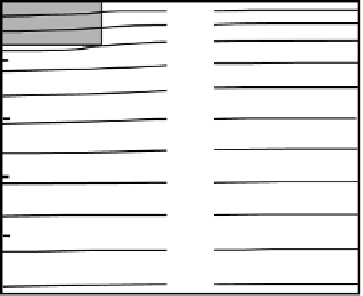Geoscience Reference
In-Depth Information
(a)
Figure 7.18.
(a) Dimensions and
physical parameters of
the two-dimensional
burial and intrusion
models. Initial
temperature, equilibrium.
The heat generation,
A
,is
in
Distance (km)
0
100
0
UPPER CRUST A = 2.52
(granite)
100
200
300
400
500
600
LOWER CRUST A = 0.42
(gneiss)
Wm
-3
. Because the
model is symmetrical
about the left-hand edge,
only half is shown. The
shaded region denotes
sediment or intrusion.
(b) The burial model after
20 Ma. Sediment had an
initial temperature of
100
◦
C and has a
radioactive heat
generation of
0.84 Wm
-3
. The
sediment has very little
effect on the crustal
temperatures. (From
Fowler and Nisbet (1982).)
700
800
900
1000
1100
MANTLE A = 0.042
100
(b)
Distance (km)
0
100
0
100
200
300
400
500
600
700
800
900
1000
1100
100
rapidly equilibrates towards the temperature of the surrounding country rock and
is strongly influenced by the heat production in the surrounding granite. If the
country rock had been mafic rather than granitic (see Table 7.1), the equilibrium
gradient would have been lower and thus the final temperature at the base of the
sediment would be some 50-100
◦
Clower.
Intrusion metamorphism
Figure 7.18(a) also illustrates a family of models in which a large igneous body is
intruded into the country rock. During the period immediately after the intrusion,
hydrothermal convection cells occur around the hot body, especially if the intru-
sion is in a relatively wet country rock. These cells dominate the heat-transfer
process, so the simple conductive models considered here should be regarded
only as rough guides to the real pattern of metamorphism. Convective heat trans-
fer, which moves heat more quickly than conduction alone, tends to speed up the
cooling of the intrusion. Furthermore, it tends to concentrate the metamorphic






